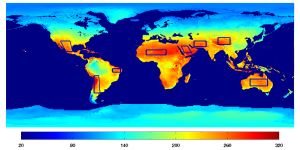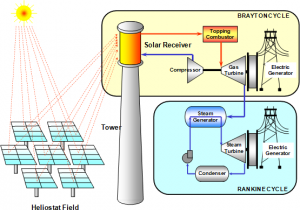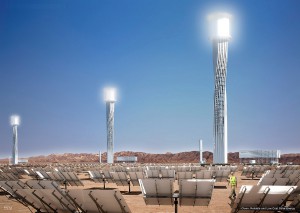Solar energy, the radiant energy produced by the sun, is steadily becoming the avenue of choice in energy production across the globe; ballooning fuel costs as well as growing concern over the dangers of global warming have made harvesting solar energy an attractive option for many countries around the world.
In Germany, solar projects, consists mostly of photovoltaics (PV), cells that convert sunlight directly to electricity, and — to a lesser extent — solar heating, the direct conversion of sunlight into heat. The country has been the world’s top PV installer for several years and still leads in terms of the overall installed capacity; that amounts to 37.8 gigawatts by August 2014, ahead of China, Italy, Japan, or the United States. Altogether, this abundance allows the PV’s to meet %8 of Germany’s electrical needs.
The graphic below depicts the total soar irradiance that falls upon the globe; when that 8% is compared with the amount of solar energy available to Germans, the achievement appears even more impressive.
In Saharn Africa, the TuNur, project is providing significant promise. Using thousands of mirrors to track the Tunisian sun to use its heat to generate electricity, the TuNur Concentrating Solar-thermal Power (CSP) plants will ultimately produce 2 Gigawatts of electricity, roughly double the average nuclear power plant. CSP, is solar technology wherein instead of directly converting the suns rays to electricity. It is instead used to superheat oil reservoirs that are then used to spin a steam powered turbine which is then used to generate electricity.
Project developer Nur Energie and its Tunisian partners, led by Top Oilfield Services, plan to construct the project in several phases.[4] On average Saharan Africa receives over 2000 kWh of electricity; by some estimates, with numbers that high. By covering just 3% of the Sahara with solar panels. All the worlds current energy needs could be met.
Closer to home, the Ivanpah Solar Electric Generating System is a solar thermal power plant in the California Mojave Desert. It uses 173,500 heliostats to focus solar energy on to boilers mounted atop 3 towers. The superheated steam this heat transfer creates is used to spin turbines to generate the 377 MW the plant can produce on a good day. That is enough to power 144,000 homes.[5]
While, solar power can provide a lot of clean power, with minimal maintenance. High capital start up costs (the TuNur plant had a 400 M Euro price tag ), as well variable weather over most of the world make large scale projects less than feasible. However, as Germany has shown, small scale photovoltaic can produce substantial energy output in relatively sunless climates. As the cost to produce each kilowatt of solar electricity falls (4.5 cent/kWh ) and their efficiency continues to improve [6], solar power may prove to be the saving technology our planet so desperately needs.
Sources
[1] http://en.wikipedia.org/wiki/Solar_power_in_Germany
[2] http://www.euractiv.com/energy/steps-bring-saharan-solar-europe/article-184274
[3] http://www.desertec.org/press/press-releases/120124-01-desertec-foundation-tunisian-sun-will-light-european-homes-by-2016/
[4] http://www.desertec.org/press/press-releases/120124-01-desertec-foundation-tunisian-sun-will-light-european-homes-by-2016/
[5] http://www.brightsourceenergy.com/ivanpah-solar-project#.VD8CzWfRiSo
[6] http://pureenergies.com/us/how-solar-works/solar-panel-efficiency/


